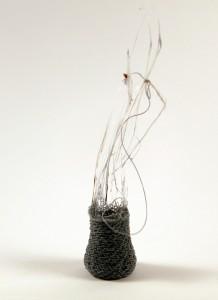Artist and digital philosopher David Lobser wanted to find out what would happen if 3D printing were used as a tool for drawing directly in three dimensions, rather than for printing a three dimensional version of a digital model. Rather than going down the typical path toward the use of 3D printing as a way of replicating extremely precise geometries, Lobser wanted a messier but more direct way of utilizing the technology. He used Javascript to create G-Code, but in what might be termed a chaotic manner. It isn’t random, but slight changes in any one of the inputs leads to unpredictable variations in the output, making the process almost quantum in nature. Lobser explained his process:
“For this series of prints I used Javascript to generate G-Code in a simplified and intentionally messy way. I dispensed with the need to ever create three dimensional models and instead treated the Makerbot as a drawing device. I began with a simple spiral and then added layers of complexity, tuning and experimenting with each iteration.”
 The vessels created are of an amazing variety with spindly tenous fibers, almost silk-like in their appearance working together to create a ghostly container. Much in the same way that birds create solid nests out of the most ephemeral of materials, the vessels Lobser produces appear to be precious objects that should be viewed with reverence and handled with care. The only thing lacking is the delicate cargo of eggs on the inside.
The vessels created are of an amazing variety with spindly tenous fibers, almost silk-like in their appearance working together to create a ghostly container. Much in the same way that birds create solid nests out of the most ephemeral of materials, the vessels Lobser produces appear to be precious objects that should be viewed with reverence and handled with care. The only thing lacking is the delicate cargo of eggs on the inside.
Lobser’s effort to use 3D printing as more than just a prototyping tool and move it into the realm of an expressive medium in its own right exemplifies his interests as an artist. While he recognizes that there may very well be practical applications for the technique he is utilizing, he is primarily interested in the aesthetic possibilities that such coding-to-creation presents.
As are so many others in the up and coming 3D printing culture, he is part of the open source movement and shares his coding freely for others to modify and interpret as they wish. In addition, you can click through his blog to create your own vessel using WebGL. Once you open the drop down control panel, a series of sliders lets even the most inexperience individual create modifications to a cylindrical vessel with changes you can see in real time as they occur. When you are satisfied with the output, you can export the code — et voilá! — you have the code necessary to create your own unique vessel.
 Who knows, if you put it outside, you might even get a family of wrens to join in your appreciation of the art of 3D printing. Discuss Lobser’s work in the Unique G-code forum thread on 3DPB.com.
Who knows, if you put it outside, you might even get a family of wrens to join in your appreciation of the art of 3D printing. Discuss Lobser’s work in the Unique G-code forum thread on 3DPB.com.
Subscribe to Our Email Newsletter
Stay up-to-date on all the latest news from the 3D printing industry and receive information and offers from third party vendors.
You May Also Like
3D Printing Unpeeled: Wind Turbines, Probiotics and Lenses
TPI Composites, ORNL and Ingersoll Rand are working to make wind turbine tooling segments that can be 18.3 meters long. These elements also include resistive wires that help keep the...
3D Printing Unpeeled: Digital FDM Filament for Functional Gradients
Just published in Nature, a paper by a Seoul National University team looks at “3D printing with a 3D printed digital material filament for programming functional gradients.” Sang-Joon Ahn, Howon...
3D Printing Unpeeled: $5000 Cold Spray 3D Printer, Roland DGA & Living Materials
The AeroForge is a $5000 cold spray metal printer for copper made by a student team at Rice University. In a paper for ACS Central Science a team from Nanjing...
3D Printing Webinar and Event Roundup: April 28, 2024
In this week’s 3D Printing Webinar and Event Roundup, the Ceramics Expo is taking place in Michigan, Stratasys continues its advanced training courses, and SPE is holding a Polymer Characterization...































